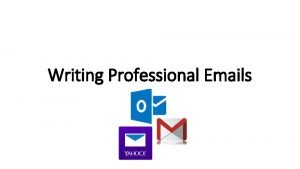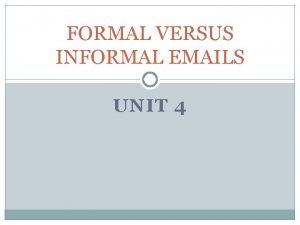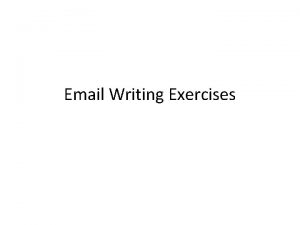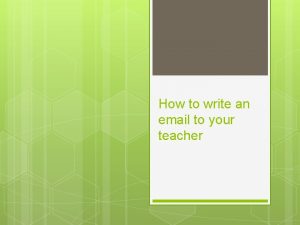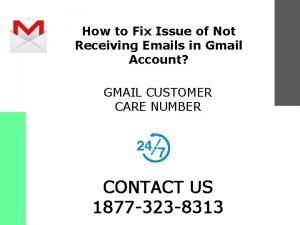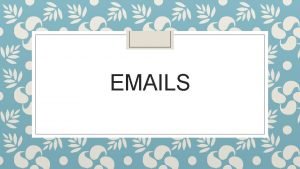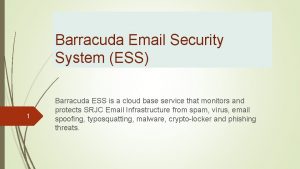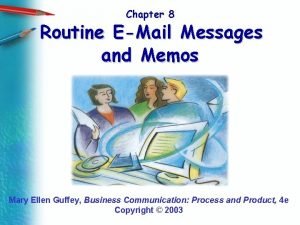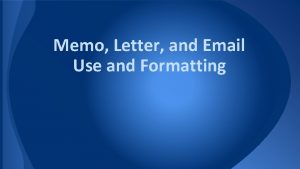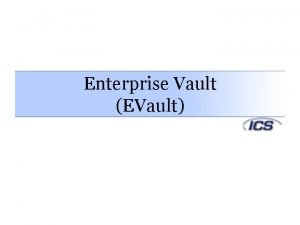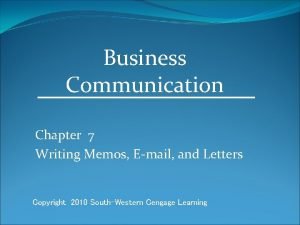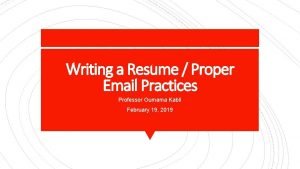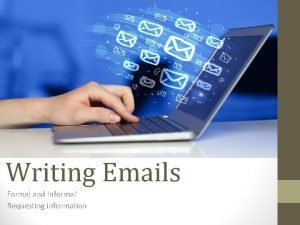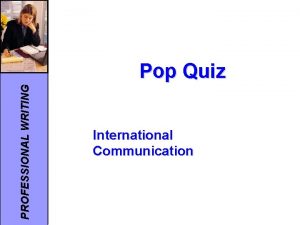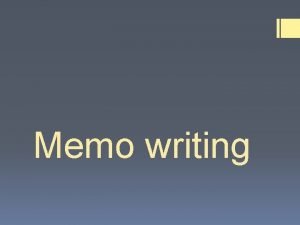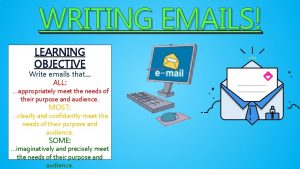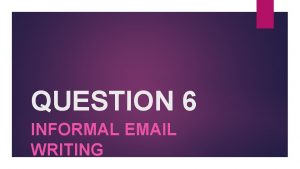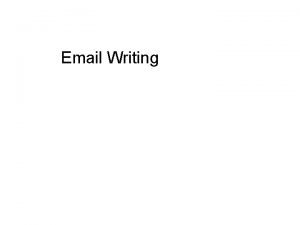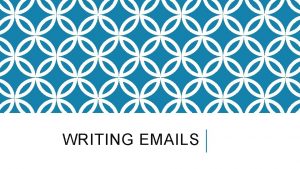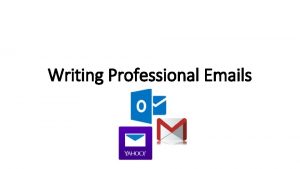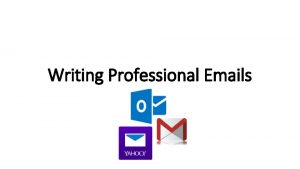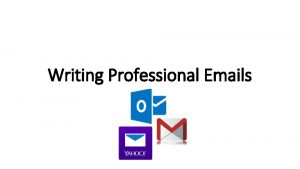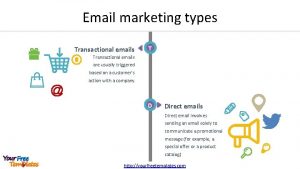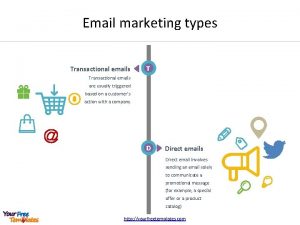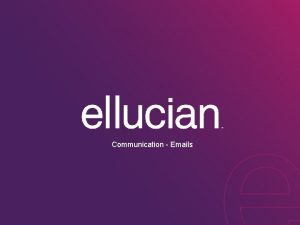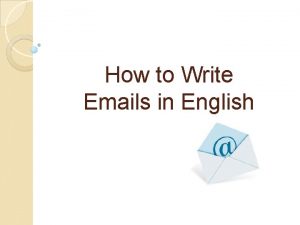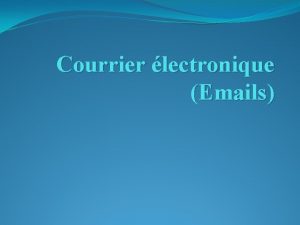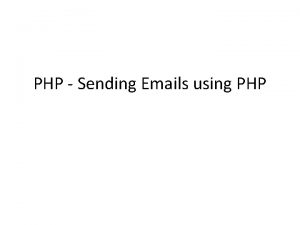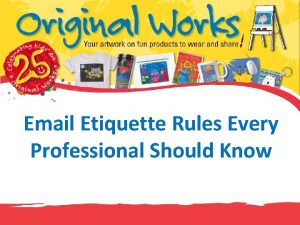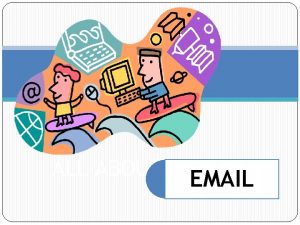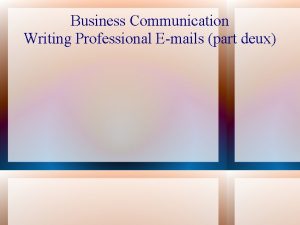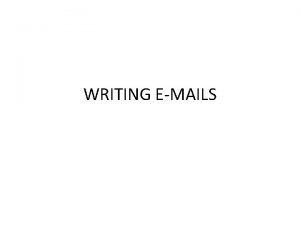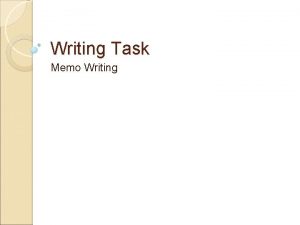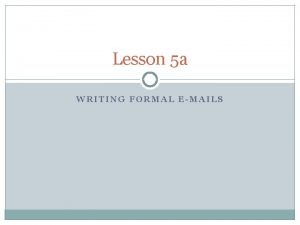Writing Professional Emails Email An Email is a
























- Slides: 24

Writing Professional Emails

Email • An Email: is a message distributed by electronic means from one computer user to one or more recipients via a network. • Emails could be used for personal purposes to communicate with friends and family, but their importance raises from using them in formal correspondence.

Formal Email • A Formal Email: is an email you write to person that you have a noncasual relationship with, such as: • • • Your Professor Your Superior (Manager, Team Leader, …etc) Your Colleague Prospective Employer Or, someone you don’t know, …etc.

Main Parts of an Email • Any email, format or informal, contains the following parts: • Sender • Reciever(s) • Subject • Message Body • Salutation • Body Paragraphs • Closing

Main Parts of an Email

Sender and Receiver • Sender: The person who writes the email. • Receiver: The person(s) that receive(s) the email. • You can place the email of the receiver(s) in 3 boxes, labeled as: • To: Here you place the email(s) of the main receiver(s), who is/are the main target of the email, and who is/are concerned of the email topic. • CC: Here you place the email(s) of the receiver(s) that are interested in the topic of the email, but are not the direct target of it. For example: If you are a team leader, you send an email To a member to perform a certain task, but CC the other members for their information. • BCC: A hidden copy of the email that you might need to interested to certain person(s) while hiding their email addresses.

Sender and Receiver • Important Note: • Make sure that you write the right email addresses in the Receiver parts. • An email sent to a the wrong email address may cost your job.

The Subject • The email subject is an essential part of your email. If you leave it empty, most email systems will give warning about it. • Why Subject is important? • The subject of an email, is the first thing a receiver reads in an email. And according to the subject, he/she decides to read the email now, later, or maybe never.

How to write an appealing Subject? • The subject should relate to the email body and be something that would convince the receiver to open the email. • Make it short, clear and stick to the point. (Keep your subject line 5 words or less. ) • It is OK to have “Re: ” or “Fwd: ” in the Subject line, to show that you are replying to the original sender, or forwarding a previously received email. • It is ok to add numbers, to be more clear (e. g. 2 -day vacation, 50 Jds Payback, …etc. ) • Write the subject line using the “Title Case”, i. e. every word in the subject starts with capital letter.

Subject Line: Don’t… • Don’t use “Re: ” or “Fwd: ” if it is your first email to the receivers. • Don’t write the subject as a question. • Don’t use exclamation mark. • Don’t use greetings (i. e. Hi, Hey, Hello, …etc. )

Email Body • The Email body, is the letter you are concerned to send to receiver. • In formal emails, it is better to write briefly unless you need to outline details. • Email Body consists of three main parts: • Salutation (greeting and addressing the receiver) • Body Paragraphs • Closing and signature

Email Body – Salutation (Greeting) • If you don’t know who you are writing the email to, you can start your email with: • To Whom it May Concern • Dear Sir/Ms. • If you know the name of the person, start with: • Dear Mr. Smith -- if he is a man • Dear Ms. Smith – if she is woman • Notes: • Use the last name of the receiver, not the first (Regarding the countries that use the last name in corresponding) • Don’t start the greetings with “Hi”, “Hello” or “Hey”

Email Body – Paragraphs • Try to make them short and concise. • Start with an opening statement, such as: • I hope my email finds you will • I hope all is well with you • Thank you for your prompt respond • Thank you for accepting my application, …etc

Email Body – Paragraphs • Depending on the subject, you should have a maximum of four paragraphs and each paragraph should contain a single point. • It is important to provide questions in order to prompt response. • Again, make it clear and concise.

Email Body – Paragraphs • After the last paragraph close with a thank you line, or an action that you are expecting. • For example: • Thank you for your cooperation • Thank you for your assistance with… • Thank you for your time and I look forward to hearing back from you. • Please feel free to call or email me if you have any questions. • Your prompt response is highly appreciated. • I would appreciate it if this could be taken care of promptly.

Email Body – Closing • Close with: • • Thank you Best Regards Sincerely Yours • Add your signature (this can be added automatically) • Then your full name • It is useful sometimes to add your job position (if applicable), and phone number.

Tips for writing an email • Do not use contractions: • For example: don’t, haven’t, I’m, isn’t. • Instead use: do not, have not, I am, is not, …etc • Do not write in all capital letters. • For example: Please reply SOON! • But, you can use them for abbreviations, such as, KSA, JU, …etc. • Use formal vocabulary, do not use slang. • Proofread your email. • Check that you do not have spelling or grammatical mistakes. • Read your email at lease twice, and take second opinion if possible. • Use polite language, even if you are sending a complaint.

Writing a Cover Letter • A Cover letter: is a single-page letter that should be part of any job application. • If you are handing a hardcopy of the CV, this page will be the first one. • If you are handing a softcopy, usually a cover letter is written in the email body, where you are attaching your CV. • In this letter you give a quick presentation about yourself, to attract an employer to read your CV.

Writing a Cover Letter • Take into considerations: • The cover letter is a formal letter, so all previous tips count. • The purpose of this letter is to: • Introduce you. • Mention the job you are applying for. • Match your skills and expertise with the ones requested for the job. • Finish with a call of action (for example: requesting an interview, or asking to meet).

Example of a poor communication, Why?

Example of a good communication

Exercise • Write a formal email: • To your teacher saying that you have questions about the course and that you need to set an appointment with him/her to discuss this issue. • To your boss, declaring that you have accomplished the task requested from you, and asking for his/her feedback.

Any Questions?

References • https: //englishlive. ef. com/blog/career-english/write-perfect-professional-emailenglish-5 -steps/ • https: //www. yesware. com/blog/how-to-write-a-professional-email/ • https: //www. city. ac. uk/__data/assets/pdf_file/0003/234354/Writing-Professional. Emails. pdf • https: //www. menlo. edu/wp-content/uploads/2015/03/writing-a-formal-email. pdf • https: //www. youthcentral. vic. gov. au/jobs-and-careers/applying-for-a-job/what-is-acover-letter/how-to-write-a-cover-letter
 Sincerely email
Sincerely email Email informal format
Email informal format Writing emails exercises
Writing emails exercises How to write an email to your teacher
How to write an email to your teacher Facegmail
Facegmail Como escribir un email formal
Como escribir un email formal Useful email phrases
Useful email phrases Barracuda deferred emails
Barracuda deferred emails A friend emails you the results of a recent high school
A friend emails you the results of a recent high school Indent messages mary
Indent messages mary Memo format email
Memo format email This item has been archived by enterprise vault
This item has been archived by enterprise vault Memos and emails
Memos and emails Oumama kabli
Oumama kabli Email rubric
Email rubric How to finish a formal email
How to finish a formal email What is professional context
What is professional context Professional writing quiz
Professional writing quiz Sample memorandum audience
Sample memorandum audience Learning objectives of email writing
Learning objectives of email writing Informal email writing questions
Informal email writing questions Learning objectives of email writing
Learning objectives of email writing Topics to write an email
Topics to write an email I am writing email
I am writing email English exit test
English exit test
